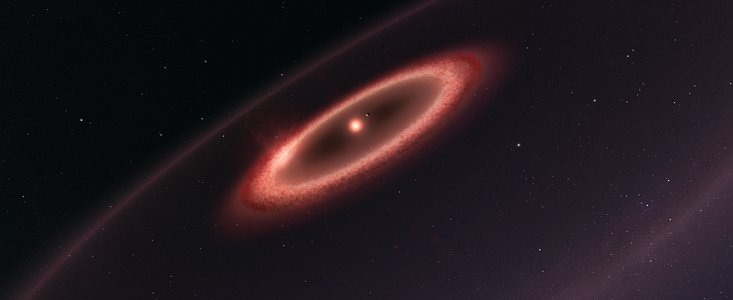Nov 6 2017
Dust around the closest star to the Solar System, Proxima Centauri, has been detected by the ALMA Observatory in Chile. These new observations expose the glow generating from cold dust in a region between one to four times as far from Proxima Centauri as the Earth is from the Sun.
The data also hints at the existence of an even cooler outer dust belt and may show the existence of an elaborate planetary system. These structures are considered to be similar to the much larger belts present in the Solar System which are expected to have developed from particles of ice and rock that failed to produce planets.
 Artist’s impression of the dust belts around Proxima Centauri
Artist’s impression of the dust belts around Proxima Centauri
Proxima Centauri is the star that is closest to the Sun. It is a faint red dwarf present just four light-years away in the southern constellation of Centaurus (The Centaur). It is being orbited by the Earth-sized temperate world Proxima b, discovered in 2016 and the neighboring planet to the Solar System. However, there is more to this system than just one planet. The new ALMA observations expose emission from clouds of cold cosmic dust adjoining the star.
The dust around Proxima is important because, following the discovery of the terrestrial planet Proxima b, it’s the first indication of the presence of an elaborate planetary system, and not just a single planet, around the star closest to our Sun.
Guillem Anglada, The key author, Instituto de Astrofísica de Andalucía (CSIC)
Dust belts are considered to be the remains of material that did not develop into larger bodies such as planets. The particles of ice and rock in these belts differ in size from the smallest dust grain, smaller than a millimeter across, up to asteroid-like bodies many kilometers in diameter.
Dust is present in a belt that extends a few hundred million kilometers from Proxima Centauri and contains an overall mass of almost one hundredth of the Earth’s mass. This belt is projected to have a temperature of almost –230 oC, as cold as that of the Kuiper Belt present in the outer Solar System.
There are also indications in the ALMA data of another belt of even colder dust almost 10 times further out. If established, the nature of an outer belt is interesting, given its extremely cold environment far from a star that is fainter and cooler than the Sun. Both belts are much far away from Proxima Centauri than the planet Proxima b, which orbits at only four million kilometer’s from its parent star.
Guillem Anglada explains the consequences of the discovery: “This result suggests that Proxima Centauri may have a multiple planet system with a rich history of interactions that resulted in the formation of a dust belt. Further study may also provide information that might point to the locations of as yet unidentified additional planets.”
Proxima Centauri's planetary system is also specifically interesting as there are plans — the Starshot project — for direct exploration of the system in the future with microprobes fixed to laser-driven sails. It is vital to have a knowledge of the dust environment around the star in order to plan such a mission.
These first results show that ALMA can detect dust structures orbiting around Proxima. Further observations will give us a more detailed picture of Proxima's planetary system. In combination with the study of protoplanetary discs around young stars, many of the details of the processes that led to the formation of the Earth and the Solar System about 4600 million years ago will be unveiled. What we are seeing now is just the appetiser compared to what is coming!
Pedro Amado, Co-author, Instituto de Astrofísica de Andalucía